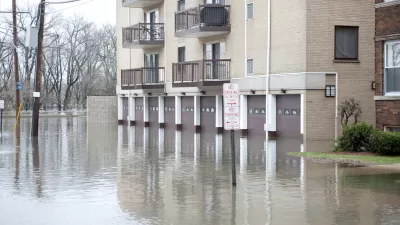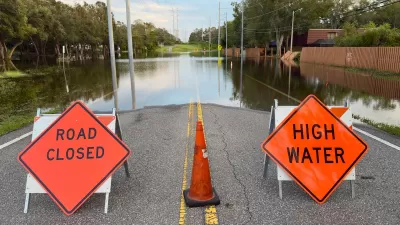Agency-funded projects will be required to be elevated at least 2 feet above the projected local flood level.

A new policy from the Federal Emergency Management Agency (FEMA) will require projects using FEMA funding to demonstrate improved resilience, reports Julie Strupp for Construction Dive.
“Starting Sept. 9 new projects and infrastructure rebuilt after a disaster with FEMA funding must be elevated at least 2 feet above the area flood level, using up-to-date data and accounting for likely impacts of climate change, per the new Federal Flood Risk Management Standard,” Strupp explains. The rule aims to build resilience into the reconstruction process to protect infrastructure from future flooding.
The agency says previous approaches are outdated due to growing flood risk. “FEMA’s new standards will increase the flood elevation and the floodplain in order to reflect both current and future flood risk. The requirement that jurisdictions account for flooding that is likely to occur in the future under climate change is new.”
The new rule will apply to roughly 35,000 FEMA-funded projects in the next decade “involving new construction, substantial improvement or repairs to substantial damage, as well as to Hazard Mitigation Assistance projects involving structure elevation, dry floodproofing and mitigation reconstruction.”
FULL STORY: Federal infrastructure projects get a (flood) raise

Trump Administration Could Effectively End Housing Voucher Program
Federal officials are eyeing major cuts to the Section 8 program that helps millions of low-income households pay rent.

Planetizen Federal Action Tracker
A weekly monitor of how Trump’s orders and actions are impacting planners and planning in America.

Ken Jennings Launches Transit Web Series
The Jeopardy champ wants you to ride public transit.

Washington Legislature Passes Rent Increase Cap
A bill that caps rent increases at 7 percent plus inflation is headed to the governor’s desk.

From Planning to Action: How LA County Is Rethinking Climate Resilience
Chief Sustainability Officer Rita Kampalath outlines the County’s shift from planning to implementation in its climate resilience efforts, emphasizing cross-departmental coordination, updated recovery strategies, and the need for flexible funding.

New Mexico Aging Department Commits to Helping Seniors Age ‘In Place’ and ‘Autonomously’ in New Draft Plan
As New Mexico’s population of seniors continues to grow, the state’s aging department is proposing expanded initiatives to help seniors maintain their autonomy while also supporting family caregivers.
Urban Design for Planners 1: Software Tools
This six-course series explores essential urban design concepts using open source software and equips planners with the tools they need to participate fully in the urban design process.
Planning for Universal Design
Learn the tools for implementing Universal Design in planning regulations.
Heyer Gruel & Associates PA
Ada County Highway District
Institute for Housing and Urban Development Studies (IHS)
City of Grandview
Harvard GSD Executive Education
Toledo-Lucas County Plan Commissions
Salt Lake City
NYU Wagner Graduate School of Public Service





























